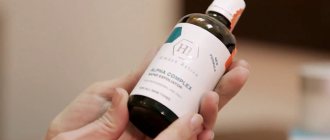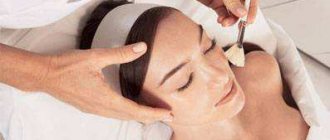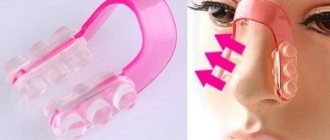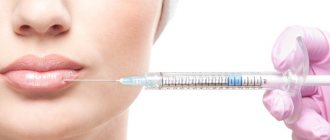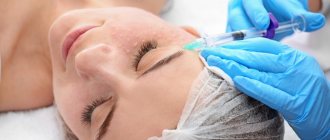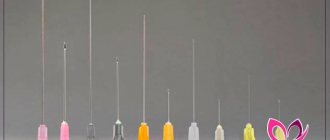The secret to effective innovation
An innovative method of cleansing and rejuvenating the skin became known recently, in 2000. It was first proposed by French mesotherapists. The innovation underwent a number of clinical studies in Brazil and quickly conquered patients and cosmetologists around the world.
Mesopeeling is a cosmetic procedure that provides a mid-peeling effect, but the patient does not experience significant peeling or post-peel side effects. Mesopeeling involves the introduction of a 1% acid solution 1–2 mm deep into the skin in certain doses. The acid composition is delivered to the epidermis and begins to actively influence the problem from the inside.
The mesopeeling procedure is aimed not so much at cleansing as at eliminating skin imperfections (wrinkles, loss of tone, enlarged pores, etc.).
Not only does this technique provide an increased effect in a short time, it eliminates injury to the integrity of the skin, does not cause extensive peeling, the development of severe redness after the procedure and inflammatory processes. It is these qualities that mesopeeling has earned mass recognition and popularity.
Please note that mesopeeling should only be performed by first-class cosmetologists. Incorrect dosage of an acidic agent during injection or violation of the drug administration technique reduces the quality of the procedure and the final result.
The combination of peeling and mesotherapy in one procedure is considered a major breakthrough in the development of modern cosmetology. Mesopeeling combines the best properties of these two procedures.
The innovative technique has many advantages compared to classical procedures:
- absence of pain and burning during execution, which are present with conventional acid peeling;
- carried out without anesthesia or painkillers;
- the technique allows you to cope with imperfections of the epidermis in the sensitive area around the eyes and mouth;
- lasting effect;
- Mesopeeling can be carried out at any time of the year;
- high efficiency of the method and quick results;
- no special preparatory measures are required before mesopeeling;
- an extensive list of indications that the innovative technique is ready to handle;
- no rehabilitation or restrictions in care, slight redness of the treated areas on the face disappears after 20–30 minutes;
- the composition of the drug for injection is selected taking into account the type of epidermis and its problems;
- absence of post-peeling swelling, blue discoloration, peeling and persistent erythema.
The mesopeeling procedure has significantly facilitated the tasks assigned to cosmetologists in rejuvenating and eliminating skin problems. Immediately after the procedure, the face becomes fresher and looks younger, and the shade of the epidermis is evened out. You can judge the full effect after a course of mesopeeling, after 1–1.5 months.
The gentleness of the effect, the safety of the process and the low concentration of acid allow the procedure to be carried out even during pregnancy and lactation.
What is mesopeeling?
As already mentioned, mesopeeling is the result of combining a traditional peeling procedure and a technique from the arsenal of alternative medicine used to treat various quite serious diseases - mesotherapy, which was first tested at the turn of the 20th and 21st centuries.
Mesotherapy first began to be used in the sixties of the last century in France. The essence of this therapeutic method was that an anesthetic (pain-relieving solution) - procaine - was injected into the deep layers of the skin, mainly for the purpose of dulling attacks of pain. Later, doctors using this technique began to notice that this drug has a number of other beneficial properties, and the scope of mesotherapy expanded. Recently, mesotherapy has been used mainly for cosmetic purposes, but with the advent of special preparations based on diluted glycolic acid, this technique was included in mesopeeling, which has already become widespread in many countries and has a number of positive reviews.
Who is the procedure recommended for?
The innovative technique has a considerable range of indications typical for different age categories. These include:
- hyperkeratosis;
- chrono- or photoaging;
- loss of skin tone;
- rapid rate of appearance of wrinkles and facial folds on the face;
- pigmentation, freckles and congestive acne spots;
- comedones, blackheads;
- “goose bumps”, enlarged pores;
- shallow scars, stretch marks and scars;
- dryness, feeling of tightness;
- oily sheen, disruption of the sebaceous glands;
- problematic acne, frequent acne;
- seborrhea;
- vitamin deficiency of the skin, unusual grayness and dullness of color.
Mesopeeling is recommended to be used not only purposefully to solve existing skin problems, but also as a preventive measure.
Types of mesopeelings
Mesopeeling procedures may differ from each other in the composition used. The final result largely depends on what acid is included in the product. For example, if you experience weakening tone and turgor, wrinkles appear and all the signs of aging are evident, cosmetologists will recommend using retinol (vitamin A). It will have an enhanced rejuvenating effect and cleanse the skin.
Several acids are used to transform the face. Let's consider their action and determine in which cases it is better to use them:
- Lactic acid – suitable for patients with sensitive and very sensitive skin. Lactic acid is found in small amounts in skin cells, so it does not cause rejection or any complications. In addition, lactic acid has an antimicrobial, healing effect;
- glycolic acid – has a moisturizing and rejuvenating effect. This component activates the production of collagen fibers and elastin and prevents aging. Mesotherapy with glycolic acid is ideal for patients suffering from dry epidermis and flaking. Glycolic acid molecules slow down the formation of natural melanin, which delays the appearance of pigmentation on the face;
- the addition of retinol is used for mature skin. Retinol has a high anti-aging effect, increases its protection and helps lighten age spots and congestive spots;
- salicylic acid - ideal for problematic and oily epidermis. The main component fights acne, pimples and inflammatory processes from the inside. The disadvantage of salicylic acid is a high risk of irritation, compared to glycolic or lactic acids. Follow your cosmetologist's recommendations to minimize this risk.
Regardless of the chosen composition, mesopeelings cannot be performed at home. Only professional execution guarantees high efficiency in correcting skin defects.
Which is better to choose?
The decision to choose peeling or mesotherapy is made individually. Getting your skin in order by peeling will cost less . But the cost will depend on the variety chosen. There are several types of peeling and each has its own characteristics. This procedure can also be performed at home.
Attention! If you have time and money, it is worth taking a course of mesotherapy. But it is better to consult a cosmetologist. He will assess the condition of the skin and recommend the most effective procedure in a particular case.
The vitamin cocktails used during processing are almost identical . For this reason, both techniques can be used separately or together. The combination results in mesopeeling.
We recommend: Is it possible to do peeling before a solarium or a trip to the sea? Pros and cons of tanning before and after the procedure
Peeling before mesotherapy
The classic option involves performing mesotherapy after peeling with a difference of 4–9 days.
There is another possibility: on the eve of mesotherapy, peeling is performed, and then for 3 days the cosmetologist gives beauty injections . After 7 days, you can repeat exfoliation.
During the recovery period of the epidermis after exfoliation, it is necessary to use creams containing glycolic acid and products intended for sun protection.
Is it possible to do it at the same time: a combination of procedures
The combination of exfoliation and mesotherapy is based on a vitamin cocktail containing hyaluronic acid. Its concentration is 1–2%.
The benefits of mesopeeling include:
- mutual enhancement of the effect of acids;
- reduction of the rehabilitation period;
- minimal trauma;
- pronounced effect of rejuvenation and whitening;
- the possibility of performing the procedure in summer, when the sun is active;
- penetration of acids into deeper layers of the skin.
Mesopeeling is suitable for women of all ages.
But such a combination of cosmetic techniques is not without its drawbacks. The injection sites remain sore, sometimes bruising and redness appear . The possibility of developing an allergic reaction cannot be ruled out.
The course consists of 3–7 procedures at weekly intervals. A slight lifting effect and evening out the tone of the epidermis are visible almost immediately.
On a note! The combination of procedures is especially effective for facial rashes caused by hormonal imbalance.
In combination with mesotherapy, superficial exfoliation is used, which affects the outer layers of the skin. Beauty injections are given into the middle layers of the epidermis, due to this the procedures do not overlap each other in their action.
Mesotherapy before peeling
If you ask a dermatologist whether it is permissible to perform peeling after beauty injections, he will say that it is possible.
This is done in order to enhance the effect. Peeling after mesotherapy, as well as before, increases the effect of hyaluronic acid , helps saturate cells with oxygen, and doubles the achieved result.
When exfoliation acts as a preparatory step for mesotherapy, the main component of vitamin cocktails – hyaluronic acid – creates the conditions for prolonged cell activity. The use of peeling after revitalization makes the rejuvenating effect more pronounced. The results obtained last longer.
We recommend: A popular modern procedure - glycolic peeling: how is it done in the salon and at home? Nuances
Technology and care after the procedure
In terms of technique, the procedure resembles classical mesotherapy. No preparation is required from the patient before performing the technique.
The transformation process is simple, but requires professionalism and skills in injection cosmetology:
- The face is cleaned of dust particles, fatty deposits or makeup residues. To do this, use a cleanser (milk, lotion).
- Using a special needle, the drug is injected 1–2 mm into the skin. First, the cosmetologist goes over the entire face, and then separately treats wrinkles, scars and problematic folds.
- At the end of the injection, the remaining product is removed and the cream is applied to the face.
Before mesopeeling, the cosmetologist checks how the skin reacts to the exfoliant. If irritation and unusual effects occur, the composition is replaced with another.
Mesopeeling does not involve complications or side effects, so the patient can immediately go home and do their usual activities.
There is no rehabilitation period as such, but certain recommendations must be followed. For example, experts advise using creams and cosmetic products for the skin that promote rapid restoration of the skin and prevent peeling.
LiveInternetLiveInternet
Makita87
all posts by the author Modern cosmetology provides us with many opportunities to improve our appearance. Mesotherapy, radiofrequency lifting, dot therapy, biorevitalization, etc... What is hidden behind the beautiful scientific names? Of course, if you have a good cosmetologist who you can trust, then there is no need to understand this terminology. But, in most cases, you need to at least imagine what this or that cosmetic procedure is and why it is used. Let's consider some of them.
Biorevitalization
Biorevitalization is the injection of hyaluronic acid-based preparations into problem areas of the skin. The choice of a specific drug usually depends on the problem being solved. The main active ingredient in this procedure, hyaluronic acid, is widely used in modern cosmetology due to its pronounced moisturizing and rejuvenating effect. The biorevitalization procedure eliminates fine wrinkles and, to a certain extent, prevents their further formation. Cosmetology specialists recommend thinking about the need for biorevitalization of facial skin from the age of 25-28. One of the indications for this procedure is the regular influence of negative factors on the body, such as poor environmental conditions, overwork, smoking, and exposure to ultraviolet rays. The appearance of early wrinkles can also be associated with rapid weight loss due to dieting.
The biorevitalization procedure allows you to normalize the level of skin hydration and stimulate the synthesis of collagen and elastin, which are responsible for the firmness and elasticity of the skin. When used in a timely manner, biorevitalization allows you to get rid of fine wrinkles, activate metabolic processes in the skin, and significantly rejuvenate the skin without resorting to complex surgical methods fraught with complications.
More information about biorevitalization: https://kosspa.ru/metod/biorevitalizacija/index.html
Chemical peels
Superficial peelings are one of the “softest” anti-aging procedures that have a minimal number of side effects. With superficial peeling, only the top layer of skin is affected - peeling helps the process of skin cell renewal: old, keratinized cells are separated, the skin texture is slightly evened out, and fine wrinkles disappear. Metabolism, blood circulation and removal of harmful substances from the skin are stimulated. The skin begins to “breathe easier”, the processes of protein synthesis, which are responsible for its firmness and elasticity, are activated.
Medium peels do not only affect the deeper layers of the skin. Medium peeling is an effective remedy for solving many cosmetic problems, including the fight against superficial and medium-deep wrinkles. The procedure stimulates the separation of dead skin cells and their replacement with young cells, enhances blood circulation, removes harmful substances from the skin, generally increases the level of metabolism in skin cells and gives a pronounced rejuvenating effect.
More information about chemical peels: https://kosspa.ru/metod/piling_himicheskij/index.html
Mesotherapy
Mesotherapy is an intradermal injection of “cocktails” of medications (vitamins, microelements, plant extracts, etc.) into problem areas. The “cocktail” for mesotherapy is usually selected individually, taking into account the problems and characteristics of your skin. The technique was proposed several decades ago and during this time has received widespread recognition. Injections are made “manually” with thin needles in very small doses or “hardware” - using a special device that allows you to automatically dose the amount of the drug.
The mesotherapy procedure stimulates the processes of skin renewal and restoration by enriching the deep layers of the dermis with active elements.
More information about mesotherapy: https://kosspa.ru/metod/mezoterapija/index.html
There are many methods for preserving beauty and “rejuvenation”. New ones appear every year. It is no longer possible to ignore modern achievements in cosmetology. But remember that the procedure is not performed by an expensive device, not by a medical center, but by a specific cosmetologist. Be careful when choosing a doctor whom you trust with your beauty and health.
How many procedures will be required
Mesopeeling is carried out in courses of 3–7 sessions, in some cases their number can be increased to 10. The duration of the course is selected by the cosmetologist solely based on the characteristics of the skin and the degree of defects on the face.
Mesopeeling should be carried out depending on the structure of the skin. It is allowed to perform such procedures once every 7 days for patients with thin and sensitive skin. If your skin is oily, thick or problematic, then sessions are held every 3-4 days.
To increase the effectiveness of manipulations, it is recommended to alternate mesopeeling with classical mesotherapy.




